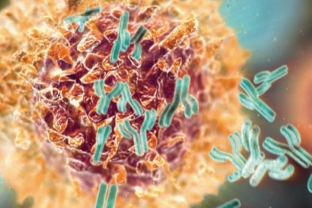How did the story of a patient with undiagnosed T – cellular lymphoma of the skin, you can find out in our previous article. After re-admission of the patient to the clinic & nbsp; survey was carried out. An objective examination of the skin revealed multiple spots with rounded outlines of pink – red, which had clear boundaries. The spots were from 1.5 to 7 cm in diameter, there were no peelings on the surface of the rashes. A cyanotic border was noted along the periphery of the elements of the rash. Nail plates, hair and mucous membranes are not affected, lymph nodes are not enlarged.
Research results of a patient with undiagnosed T – cellular lymphoma of the skin
Concomitant diseases of patient K. are: ischemic heart disease, atherosclerotic cardiosclerosis, heart failure stage II, hypertension stage II, extrasystole, dyslipidemia, obesity of the 2nd degree, chronic sinusitis and chronic gastritis in remission, dyscirculatory encephalopathy of the 2nd degree, osteochondrosis , osteoporosis.
Laboratory data of a patient with T – skin cell lymphoma:
- clinical blood test – leukocytosis, other parameters are normal;
- general urinalysis – without pathologies;
- antibodies to the human immunodeficiency virus were not detected;
- blood test for HBs – antigen negative;
- Vidal test is negative.
Data of histological examination of elements at T – skin cell lymphoma
Based on the examination and laboratory tests, the diagnosis of erythema multiforme toxico – allergic genesis. Read more on histological examination data on estet-portal.com. To verify the established diagnosis, a diagnostic skin biopsy was performed in the area of the spot on the chest. the results of the histological examination are as follows: in some places the epidermis is thinned, the basal sections are vacuolated, and subepithelial blisters are formed. In the dermis – diffuse infiltration and edema. Plasma impregnation of the walls was observed in the vessels. All these data and indicators fit into the diagnosis of erythema multiforme exudative, in the absence of suspicions of the likelihood of T – cellular lymphoma of the skin.
Treatment with prednisolone at a daily dose of 40 mg, antihistamines and topical steroids was carried out. The patient was discharged again with blanching of rashes and elimination of subjective sensations.

Based on what symptoms was diagnosed T – skin cell lymphoma?
Six months later, the patient went to the clinic with complaints of the same rashes, which were accompanied by itching. In addition to the old foci, new elements of the rash appeared on the skin of the lower extremities. But now the rashes had other objective characteristics. They were in the form of rounded plaques from cyanotic to bright – of red color. The rash slightly protruded above the surface of the skin, had clear boundaries and measured from 2 to 5 cm in diameter.
Painful knot on the shoulder drew attention crimson – bluish in color, with ulceration in the center.
Against the background of polymorphism of symptoms from weakly infiltrated plaques to nodular elements, skin lymphoma was diagnosed at the stage of transition from plaque to nodular form. To confirm the diagnosis, a diagnostic biopsy of the node of the left forearm was performed.
The histological picture corresponded to T – cellular lymphoma (mycosis fungoides), there was no fixation of immunoglobulins. Immunohistochemical study with antibodies to CD3, CD4, CD5, CD8, CD20 proteins revealed positive cytoplasmic staining. The immunohistochemical picture corresponded to the diagnosis of T – cellular lymphoma of the skin. The proliferation index was 55%.
Thus, diagnostics T – cellular lymphoma of the skin in the early stages is difficult. In some cases, false diagnoses may even be confirmed histologically, as in the case described above.
Establishing the diagnosis is complicated by the fact that the histological picture of T – cellular lymphoma of the skin is not specific and can be regarded as a manifestation of chronic dermatosis. Dermatologists should remember that T – cellular lymphoma of the skin must be excluded in any atypical course of dermatological pathologies.







Add a comment